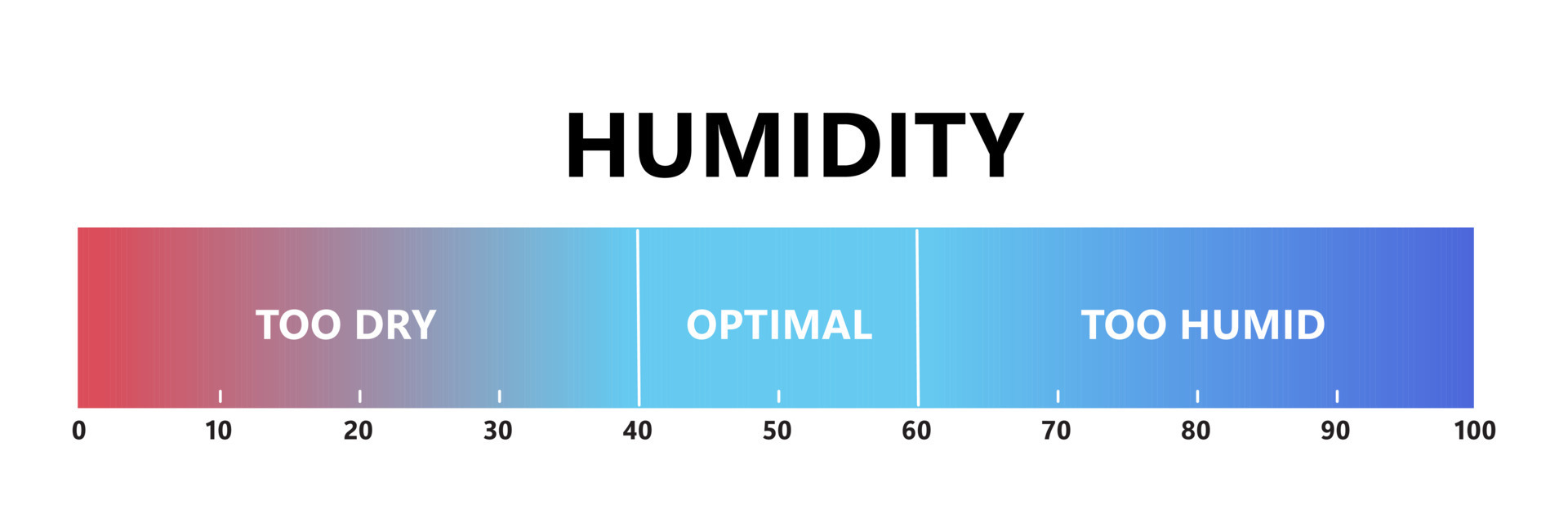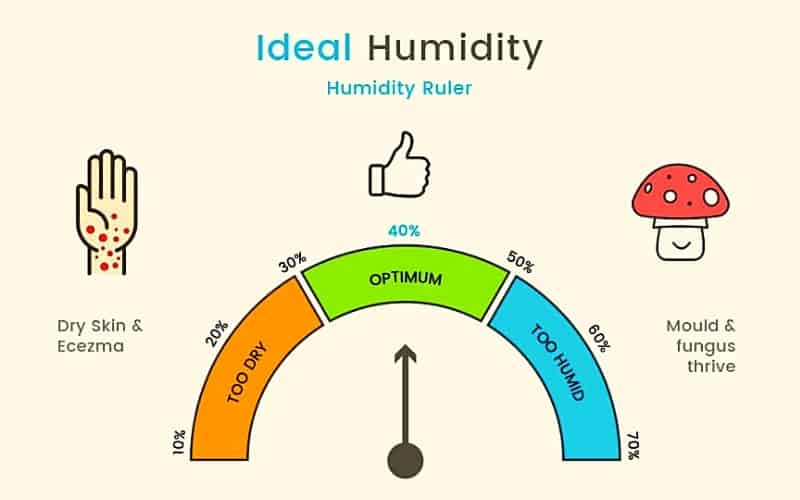What Level Of Humidity Is Considered Dry

Understanding humidity is crucial for anyone involved in the HVAC (Heating, Ventilation, and Air Conditioning) industry. Whether you're a student just starting out, an experienced technician looking to expand your skillset, or an employer seeking qualified professionals, knowing what constitutes "dry" air is fundamental. This article will provide a comprehensive overview of humidity levels, their impact, and the career opportunities available in this vital field.
Defining Dry Air: Relative Humidity Thresholds
Defining "dry air" isn't as simple as a single number. Instead, it's best understood in the context of relative humidity (RH). Relative humidity represents the amount of moisture in the air compared to the maximum amount the air can hold at a given temperature. It's expressed as a percentage.
Generally, air with a relative humidity of below 30% is considered dry. However, the ideal range for comfort and health typically falls between 30% and 60%. When RH drops below 30%, several issues can arise:
- Health concerns: Dry air can lead to dry skin, irritated sinuses, sore throats, and increased susceptibility to respiratory infections like the flu.
- Material damage: Wood furniture, musical instruments, and even artwork can crack or warp in extremely dry conditions.
- Increased static electricity: Lower humidity makes static shocks more frequent and intense.
The Importance of Monitoring Humidity
Maintaining proper humidity levels is essential for occupant comfort, health, and the preservation of property. This is where HVAC professionals play a critical role. They are responsible for installing, maintaining, and repairing systems that regulate both temperature and humidity. This includes:
- Humidifiers: Add moisture to the air.
- Dehumidifiers: Remove moisture from the air.
- Air conditioners: Can remove moisture as part of the cooling process.
- Ventilation systems: Ensure proper airflow and prevent the buildup of excessive moisture.
Impact of Dry Air on Building Environments
Different building types have different humidity needs. Consider these examples:
- Residential Buildings: In homes, dry air can cause discomfort and health problems for occupants. Properly sized and functioning humidifiers and dehumidifiers are crucial.
- Commercial Buildings (Offices, Retail): Dry air can negatively affect employee productivity and customer comfort. HVAC systems must be designed to maintain a stable and comfortable humidity level throughout the building.
- Industrial Buildings (Manufacturing, Warehouses): Specific industries require precise humidity control. For example, in electronics manufacturing, static electricity from dry air can damage sensitive components. In food storage, humidity levels affect shelf life and prevent spoilage.
- Healthcare Facilities (Hospitals, Clinics): Maintaining proper humidity is critical to prevent the spread of infections and ensure patient comfort and recovery.
The HVAC Career Landscape: Opportunities and Requirements
The demand for skilled HVAC technicians is consistently strong. According to the U.S. Bureau of Labor Statistics, the job outlook for HVAC mechanics and installers is projected to grow 6 percent from 2022 to 2032, about as fast as the average for all occupations. This growth is driven by the increasing need for energy-efficient systems and the ongoing maintenance and repair of existing HVAC equipment.
Entry-Level Positions and Education
Many HVAC technicians start their careers with an apprenticeship or by completing a certificate or associate's degree program at a vocational school or community college. These programs typically cover:
- HVAC principles and theory
- Refrigeration systems
- Electrical systems
- Blueprint reading
- Troubleshooting and repair
- Safety practices
Entry-level salaries for HVAC technicians typically range from $35,000 to $45,000 per year, depending on location and experience.
Advanced Certifications and Specializations
As technicians gain experience, they can pursue advanced certifications to demonstrate their expertise and increase their earning potential. Some popular certifications include:
- NATE (North American Technician Excellence): NATE certification is widely recognized and respected in the industry. It demonstrates a technician's knowledge and skills in specific areas, such as air conditioning, heating, and refrigeration. Technicians often see increased earning potential after passing the rigorous NATE exams.
- EPA Section 608 Certification: Required for technicians who handle refrigerants. This certification ensures that technicians understand the proper procedures for handling and disposing of refrigerants, minimizing environmental impact. There are different types (Type I, Type II, Type III, Universal) that depend on the equipment you will be working on.
Technicians can also specialize in specific areas, such as:
- Commercial HVAC: Focusing on large-scale systems in office buildings, hospitals, and industrial facilities.
- Residential HVAC: Working with homeowners to install and maintain heating and cooling systems.
- Refrigeration: Specializing in refrigeration systems used in supermarkets, restaurants, and other commercial settings.
- Building Automation Systems (BAS): Programming and maintaining complex control systems that optimize energy efficiency and building performance.
Experienced and certified HVAC technicians can earn $50,000 to $80,000 per year or more, depending on their specialization and location. Some highly specialized technicians, such as those working with building automation systems, can command even higher salaries.
Career Path Examples
Here are a few examples of career paths in the HVAC industry:
- Entry-Level Technician: Starts with an apprenticeship or vocational training, assisting experienced technicians and learning the fundamentals of HVAC systems.
- HVAC Service Technician: Troubleshoots and repairs HVAC systems, performing routine maintenance and responding to service calls.
- HVAC Installer: Installs new HVAC systems in residential and commercial buildings, ensuring proper functionality and adherence to building codes.
- HVAC Sales Engineer: Works with clients to design and sell HVAC systems, providing technical expertise and developing custom solutions.
- HVAC Project Manager: Oversees the installation of large-scale HVAC projects, coordinating with contractors and ensuring projects are completed on time and within budget.
- HVAC Business Owner: Owns and operates their own HVAC company, managing a team of technicians and providing HVAC services to customers in their local area.
Employer Considerations: Hiring and Training
For employers in the HVAC industry, finding and retaining qualified technicians is a constant challenge. Here are some key considerations for attracting and developing talent:
- Competitive Salaries and Benefits: Offering competitive salaries and comprehensive benefits packages is essential for attracting top talent.
- Training and Development Opportunities: Providing ongoing training and development opportunities helps technicians stay up-to-date with the latest technologies and advancements in the industry. This can include sponsoring certifications, attending industry conferences, and providing in-house training programs.
- Apprenticeship Programs: Investing in apprenticeship programs is a great way to develop a pipeline of skilled technicians. Apprenticeships provide hands-on training and mentorship, allowing individuals to learn the trade while earning a paycheck.
- Company Culture: Creating a positive and supportive work environment can help retain employees and attract new talent. This includes fostering a culture of teamwork, providing opportunities for advancement, and recognizing employee achievements.
Industry Trends and Future Outlook
The HVAC industry is constantly evolving, driven by advancements in technology and changing consumer preferences. Some key trends to watch include:
- Energy Efficiency: Consumers are increasingly demanding energy-efficient HVAC systems that reduce energy consumption and lower utility bills.
- Smart Home Technology: Smart thermostats and other connected devices are becoming increasingly popular, allowing homeowners to control their HVAC systems remotely and optimize energy usage.
- Sustainable Solutions: There is a growing emphasis on sustainable HVAC solutions that minimize environmental impact, such as geothermal systems and variable refrigerant flow (VRF) systems.
- Improved Indoor Air Quality (IAQ): With greater awareness of the importance of IAQ, HVAC systems are now being designed to filter out pollutants and allergens, creating healthier indoor environments.
Conclusion
Understanding what constitutes "dry air" and the broader implications for HVAC systems is vital for success in this dynamic field. Whether you're a student, technician, or employer, staying informed about the latest trends and best practices is crucial. By investing in education, certifications, and training, you can build a rewarding career and contribute to creating comfortable, healthy, and energy-efficient environments for people around the world. The HVAC industry offers numerous opportunities for those with the right skills and knowledge, and a solid understanding of humidity control is an essential part of that foundation. With a growing demand for skilled professionals and continuous advancements in technology, the future of the HVAC industry looks bright.




.jpg?width=3508&name=Humidity level chart (1).jpg)





